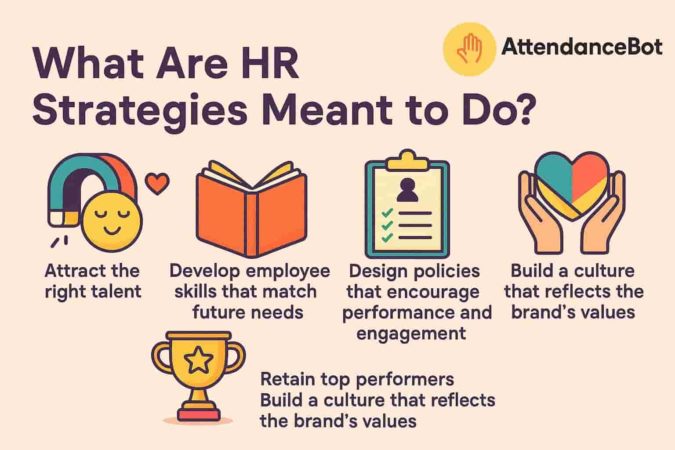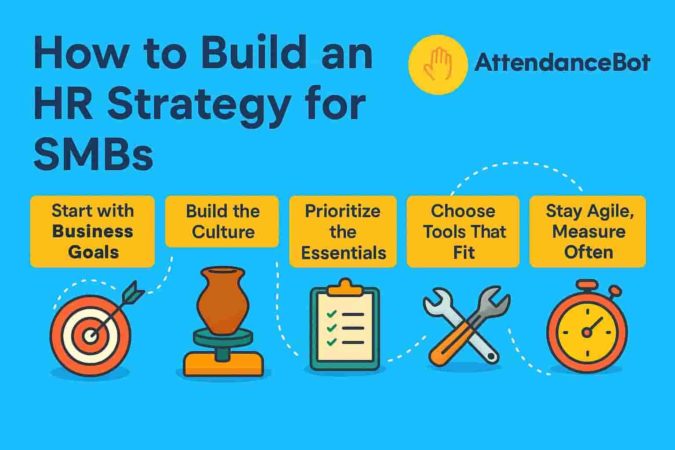When it comes to HR strategies, there’s no one-size-fits-all solution. What works for a Fortune 500 company might not make sense for a team of 30. But small and mid-sized businesses (SMBs) often look to enterprise playbooks when shaping their people practices—sometimes to their own detriment.
So, what is an HR strategy, and should SMBs follow the same path as large enterprises? The short answer: not exactly. While the principles of good HR—like aligning talent with business goals—are universal, how they’re implemented can and should vary significantly.
In this blog, we’ll explore what HR strategies are, why they matter, and how to build an HR strategy for SMBs that’s lean, flexible, and built for growth. We’ll also compare SMB vs enterprise HR strategies to help small business leaders make smarter decisions when it comes to people operations.
What Is An HR Strategy?
Every business needs a plan for managing its people—but not every business needs the same one. An HR strategy is a structured approach to aligning your workforce with your organization’s goals. It’s not just about hiring and compliance; it’s about ensuring every aspect of the employee experience—from recruitment to retention—supports your business outcomes.
So, what is an HR strategy in simple terms? Think of it as your people roadmap. It helps HR leaders and business owners determine where to allocate their time, energy, and budget to build a workforce that drives long-term success.
What Are HR Strategies Meant to Do?
The best HR strategies help businesses:
- Attract the right talent
- Develop employee skills that match future needs
- Design policies that encourage performance and engagement
- Retain top performers
- Build a culture that reflects the brand’s values
In short, HR strategies serve as a bridge between your business goals and the people who will achieve them.
How Does a Strategic HRM Plan Work?
A strong HRM strategic plan lays out clear, measurable objectives that guide every people-related decision. Whether it’s building an onboarding process or rolling out a new benefits package, each action is backed by purpose and data.
For example, an enterprise might invest in global leadership pipelines, while an SMB focuses on cross-training to stay agile. Both are valid—but they’re tailored to different contexts.
Why Every SMB Still Needs an HR Strategy
Even if you’re a 20-person team, skipping strategic planning can lead to scattered hiring, inconsistent policies, or poor retention. Knowing how to build an HR strategy for SMB operations means balancing structure with flexibility. A lean, focused plan can grow with your team—and save you from costly missteps.

What Are HR Strategies Enterprises Typically Use?
Large companies didn’t get to where they are by chance—they’ve developed robust, tightly aligned HR strategies that support thousands of employees across regions, roles, and time zones. These are rooted in long-term data insights, specialized HR teams, and extensive resources.
Enterprise HR business strategy typically emphasizes structure, standardization, and workforce planning with a multi-year horizon. As Forbes notes, empowering HR to serve as a strategic partner helps organizations align workforce initiatives with overall business direction. Forbes also highlights how leading firms embed HR into broader strategic decision-making, ensuring it supports both performance and growth objectives.
Common Enterprise-Level HR Practices
- Leadership development programs: Identify high-potential employees and ready them for executive roles.
- Succession planning: Create formal pipelines for critical roles to ensure leadership continuity.
- Global talent mobility: Relocate or rotate staff across geographies to build an agile global talent base.
- Performance management frameworks: Often detailed systems with annual reviews, ratings, and bonus schemes.
- DEI programs and compliance units: Organized teams to support diversity, equity, inclusion, and regulatory compliance at scale.
These are all solid components of a mature HRM strategic plan, but they don’t always translate to smaller teams.
What Makes Enterprise Strategies So Different?
Enterprise-level HR strategies are typically:
- Resource-heavy: Backed by HR departments with dozens (or hundreds) of specialists.
- Process-driven: Built around policies that ensure consistency across thousands of employees.
- Long-term focused: Decisions are often made years in advance, not weeks.
That makes sense for multinational operations—but it can feel overengineered for a growing SMB that needs to pivot quickly or operate with limited resources.
Why SMBs Can’t Copy-Paste Enterprise HR Strategies
It’s tempting for small and mid-sized businesses to look at what enterprise companies are doing and try to replicate it. After all, if it works for them, shouldn’t it work for you? Not quite.
The reality is that enterprise HR strategies are built for scale, not speed. They rely on rigid systems, long decision-making cycles, and dedicated departments—none of which align well with how most SMBs operate.
Cultural Fit: Enterprises Focus on Consistency, SMBs Thrive on Agility
Enterprise companies prioritize stability. Their HR business strategies focus on minimizing risk, ensuring compliance, and maintaining consistency across hundreds (or thousands) of employees. That’s why they tend to adopt formalized processes, elaborate handbooks, and layered approval systems.
SMBs, on the other hand, often rely on adaptability and speed. When you’re a 25-person team, your culture is shaped more by shared daily interactions than formal policies. Trying to enforce enterprise-level processes can feel forced—or worse, get in the way of real productivity.
Complex Systems Don’t Scale Down Well
Enterprise HR tools and systems are designed to support large-scale operations. But when SMBs adopt these tools prematurely, they often run into headaches:
- Overcomplicated workflows that waste time
- Unnecessary approvals that stall progress
- Tech stacks that are too expensive or bloated for a small team’s needs
When thinking about how to build an HR strategy for SMB growth, it’s critical to choose tools and practices that match your size—and can scale with you, not ahead of you.
Pace of Change: SMBs Move Faster
Large companies might need six months to roll out a new performance review process. SMBs can do it in a week. That speed is a strength—but it’s also a reason to avoid rigid enterprise systems.
A flexible HRM strategic plan allows SMBs to experiment, adapt, and refine processes quickly. Overengineering things in the early stages can slow growth and frustrate employees.
How to Build an HR Strategy for SMBs
So, if copying enterprise models isn’t the answer, how do you create an HR strategy that actually fits an SMB? The key is building something lean, flexible, and closely tied to your business reality. You don’t need to be rigid or formal—but you do need to be intentional.
Whether you’re building from scratch or refreshing what you have, here’s how to develop an effective HRM strategic plan for your growing team.
Start with Business Goals, Not Bureaucracy
Before diving into policies or tools, ask: Where is the business headed, and what kind of workforce will get us there?
HR strategies should support the broader business strategy—not operate in a silo. That means aligning hiring, training, and retention plans with key goals like expansion, product launches, or service improvements.
Build the Culture Before the Processes
Enterprise companies often rely on systems to drive culture. SMBs should do the reverse. When you’re smaller, culture is your biggest asset. It’s easier to shape, more personal, and can be a true differentiator in hiring and retention.
Your SMB strategy for HR should focus on:
- Clearly defined values
- Strong manager-employee communication
- Recognition and feedback that feels authentic, not templated
These don’t require massive budgets or policies—just intentionality.
Prioritize the Essentials (Not Everything at Once)
You don’t need an HR policy for everything on day one. Start with the basics:
- Recruiting and onboarding
- Time off and attendance tracking
- Performance conversations (even if informal)
- Clear compensation structures
These areas lay the foundation for more advanced HR strategies later.
Choose Tools That Fit—And Grow With You
A big lesson from enterprise HR? Tech is crucial. But unlike enterprises that build custom stacks or pay for multi-module platforms, SMBs should look for tools that are:
- Easy to implement
- Flexible across roles
- Budget-friendly
- Built to scale
If you’re exploring how to build an HR strategy for SMB, invest in platforms like AttendanceBot that automate routine tasks (like time tracking or leave management) so your team can focus on people—not paperwork.
Stay Agile, Measure Often
The best part of being an SMB? You can test, tweak, and iterate faster than any enterprise. Make the most of that.
Instead of rolling out a three-year HR business strategy, think in quarters. Try a new onboarding experience. Experiment with feedback tools. Gather employee input. Then refine.

SMB vs Enterprise HR Strategies: What’s the Real Difference?
At a glance, HR strategies in SMBs and enterprises may share similar goals—like hiring great people, building a positive work environment, and retaining top talent. But beneath the surface, they differ in some critical ways. Understanding these differences is essential when you’re figuring out how to create an HR strategy that makes sense for your organization today—not where you hope to be five years from now.
Key Differences in Strategy, Structure, and Scale
Here’s a breakdown of how SMB vs enterprise HR strategies typically compare:
| Area | SMBs | Enterprises |
| Focus | Agility, culture fit, rapid iteration | Structure, scalability, long-term planning |
| Resources | Limited HR staff, often generalists | Dedicated HR teams and specialists |
| Tools | Lean tech stacks that simplify admin | Comprehensive platforms with multi-functionality |
| Processes | Informal and evolving | Formalized, consistent, and often global |
| Hiring Approach | Value-aligned, adaptable candidates | Role-specific, skill-optimized candidates |
| Performance Management | Lightweight and feedback-driven | Systematized and policy-led |
| Compliance | Basic frameworks, often reactive | Deep legal infrastructure and global compliance planning |
Why “Borrowing” Can Be Smarter Than Copying
Instead of replicating complex systems used by global enterprises, SMBs should borrow the principles—not the processes. For example:
- Instead of a full-scale leadership development program, start with mentoring.
- Instead of enterprise-wide performance frameworks, use lightweight check-ins.
- Instead of massive HRIS platforms, look for modular tools that solve your biggest pain points.
This approach allows SMBs to stay true to their strengths—speed, culture, and closeness—while still moving toward long-term goals with a structured, scalable HRM strategic plan.
HR Strategy Examples for SMBs
Every small business has its DNA, so no two HR strategies should look exactly alike. That said, there are some smart, adaptable ways SMBs can apply big-picture thinking to their everyday people operations—without replicating complex enterprise systems.
Below are a few fictional but realistic examples that show how to build an HR strategy for SMB success, no matter your industry or team size.
Example 1: A Remote SaaS Startup With 30 Employees
Business goal: Scale quickly while maintaining strong team cohesion
HR strategy focus:
- Use async-friendly communication and onboarding tools
- Offer flexible PTO and wellness stipends to support remote work-life balance
- Roll out quarterly pulse surveys to track engagement and burnout
Why it works: This company’s HRM strategic plan is designed around speed and culture-first thinking. Instead of copying enterprise perks, they’ve built policies that match how remote teams operate day to day.
Example 2: A Local Design Agency With 12 Employees
Business goal: Improve retention and foster a collaborative culture
HR strategy focus:
- Launch biweekly feedback sessions instead of formal reviews
- Create a flexible hybrid work schedule
- Prioritize hiring based on team fit and learning potential, not just experience
Why it works: With a limited budget and bandwidth, this agency has avoided bloated systems. Their HR business strategy is lean but intentional—focused on creating a place where creatives want to stay and grow.
Example 3: A Fast-Growing E-Commerce Brand With 50+ Staff
Business goal: Prepare for expansion into new markets
HR strategy focus:
- Formalize job levels and compensation bands
- Invest in scalable time-tracking and attendance tools
- Launch manager training sessions to improve leadership consistency
Why it works: As this SMB grows, its HR strategy becomes more structured—but not overbuilt. The team is laying down scalable foundations, proving that SMB vs enterprise HR strategies aren’t about complexity, but about fit.
Final Thoughts: What SMBs Should Keep in Mind
SMBs don’t need to copy enterprise playbooks—they need HR strategies that match their scale, culture, and pace.
Knowing what an HR strategy is matters, but knowing how to build an HR strategy for SMB teams is what drives real impact. Focus on aligning HR with business goals, keeping processes simple, and choosing tech that grows with you.
A strong HRM strategic plan doesn’t have to be complex—it just needs to be intentional. Build smart, stay flexible, and evolve as your team grows.



